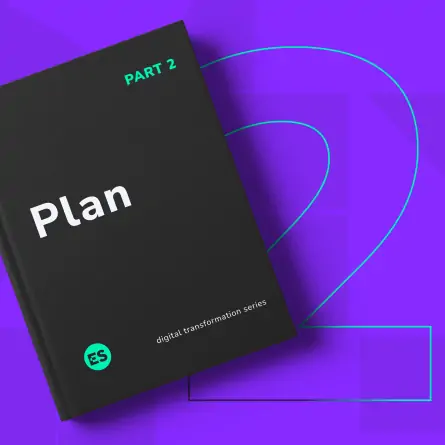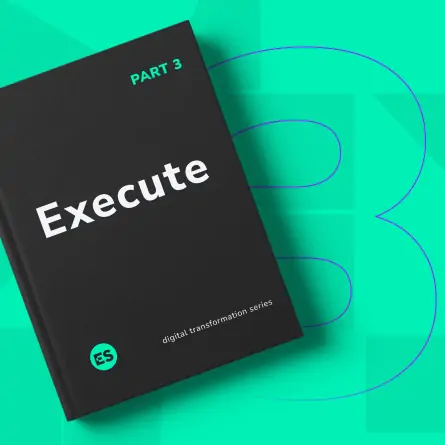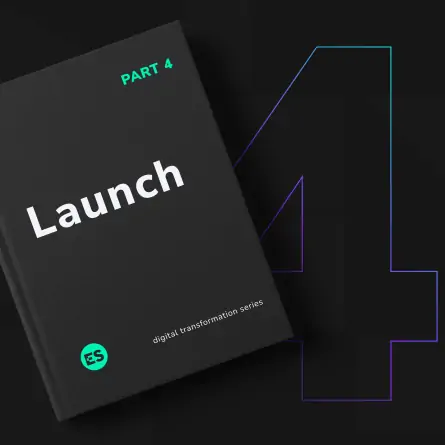Introduction to Enterprise Website Redesign
DIGITAL TRANSFORMATION SERIES
PART 1/4
There’s no way around it: Large-scale organizational website redesigns involve tricky terrain, from copious content to unpredictable UX considerations to multiple stakeholders — often across different departments and time zones. If a project of this magnitude is in your plans for 2023, here’s what you need to know to get started.
For more than a decade, our team has redesigned legacy websites and built new digital experiences from the ground up. We’ve immersed ourselves in developing digital strategies that work best for specialty industries, such as healthcare, higher education, B2B, professional services, non-profit, arts & culture, and more.
And we’ve worked with clients of all sizes — spanning everything from small local businesses with a handful of employees to dynamic global organizations with dozens of departments, scores of stakeholders, and thousands of pages of content.
As you can imagine, website redesigns that fall into this last category present the most unique challenges. They involve crafting a cohesive overarching strategy that spans:
- Design — Ensuring adherence to existing brand guidelines, creating and executing a unified look and feel that carries through all pages, and presenting large content collections in a way that meets the needs of disparate end users.
- Development — Creating intuitive information architecture and multi-layered navigation that provides optimal UX for various users, particularly those who regularly visit many different child pages within the parent organization.
- Content — Determining what stays, what goes, what needs to be added, and where it all will live.
- Analytics — Establishing tools and tactics that ensure optimal performance over the life of the site.
- Site maintenance — Making sure the site features reasonably easy upkeep and scales well as it grows in the future.
Especially in our early years, we unfortunately saw firsthand what can happen when large projects like these aren’t properly scoped, managed, or executed:
- mismanaged expectations
- expanding budgets
- overrun timelines
But we’re now able to lead successful launches of very large and complex websites and digital experiences where the teams stayed focused, healthy, and collaborative throughout the entire process. So what causes one project to be successful and another to veer off track? And what can you do to ensure the former and avoid the latter?
Over the years, we’ve spent a lot of time in internal retrospectives and casual discussion on this topic as we refined and enhanced our process. In this 4-part blog series, we explore our unique take on these topics, look behind the scenes at what the process is really like, and reveal how to get the results you’re looking for.
Understand (and Trust!) the Process
Large-scale website redesign projects are often viewed in the same simple overarching terms that work best for smaller and simpler redesigns: discovery, design, development, and launch. This is a misstep. While these phases are certainly relevant for enterprise projects, there are actually dozens of elements that make up and support each step shown in the checklist below.
ENTERPRISE WEBSITE REDESIGN CHECKLIST
Brand Alignment
✓ Consensus building/organizational alignment
✓ Brand identity
✓ Brand messaging
Research & Strategy
Audience & Users
✓ Audience research
✓ Search pattern analysis
✓ Analytics & data review
✓ Third-party research & trends
✓ Usability testing
Content Strategy
✓ Information architecture
✓ Conversion optimization
✓ Assets requirements planning (videos/imagery)
Design & Build
✓ General requirements gathering
✓ Technical requirements gathering
✓ Wireframes/UX design
✓ Visual/UI design
✓ Copywriting
✓ CMS configuration
✓ Development/implementation
✓ Integrations & third-party systems
✓ QA testing
✓ CMS rollout & training
✓ Deployment & redirects
✓ Accessibility/ADA
✓ Content migration planning
✓ Content migration: automated
✓ Content migration: manual
Measure & Optimize
✓ SEO: on-page
✓ SEO: off-page
✓ SEO: technical
✓ Analytics customization & reporting
✓ Marketing technology/personalization/sequencing
✓ Ongoing SEO and content strategy
✓ Ongoing ad campaigns (e.g., PPC/social)
✓ Ongoing technical support
Want to save a copy of this checklist for later? Download it now.
Some of the tasks on this list may seem obvious, while others feel more abstract and thus are just assumed to be part of the process — but nothing could be further from the truth.
For example: If there’s no one on the project actively assigned to provide on-page SEO strategy (keyword research, content formatting recommendations, etc.), it will not simply emerge organically during the redesign process. Designers aren’t content strategists (usually), and developers aren’t SEO experts. The bottom line? Remove all doubt and confusion from the outset by addressing every item shown here in the project plan and budget, with a prescriptive accounting for who is responsible for doing what — and when.
How Ready Is Your Organization to Get Started – and What Help Do You Need to Hit “Go”?
In our experience, the single biggest factor that causes major web projects to go awry is clients overestimating how ready they are to actually begin the process. This is why, in the earliest conversations about large-scale web projects, we identify where the organization fits into our four-part approach (which we’ll explain in depth later):

QUIZ: Where Are You on the “Readiness” Scale?
Below is a short Q&A to help you determine which aspects of the redesign you’ve already prepped and where you might need additional support.
1. Is your internal leadership and marketing team aligned on brand strategy, messaging, target audiences, and value proposition?
a. We don’t have clear internal alignment on brand strategy
b. We are mostly aligned
c. We have strong alignment on brand positioning
2. Do you have an informed understanding of your target audience personas and decision-making factors?
a. We don’t have clear definition of our audience
b. We have a good understanding of audience needs and behaviors
c. We have defined personas and conversion funnels
3. Does your website meet your needs in terms of content management, marketing features, and integrations?
a. Our website does not meet our needs
b. The website could use some work
c. We’re very happy with the website functionality
4. Do you currently have ongoing digital marketing (SEO, paid campaigns, automation)?
a. We do not have ongoing digital marketing
b. We have some things in place but could use more
c. We have everything we need in place
5. Are you effectively reporting on website traffic, behavior, and conversions?
a. We don’t have tracking in place
b. We have basic website analytics
c. We have robust funnels, goals, and event tracking in place
If you found yourself mostly answering “A”, you’ll need to establish the strategic aspects of your web presence — brand messaging, audience targeting, and content strategy — before moving into the design/build process. If your answers were mostly “B”, you’ve got some of what you need in place, but likely need help to take it to the next level. If you’re on the “C” end of the spectrum, you’re doing well, and the next step is to think about more nuanced optimization and identify new opportunities to attract and delight users.
How Eastern Standard Can Help
Enterprise website redesign projects are massive undertakings that take a significant level of expertise to manage effectively. If you need help better understanding any of the concepts presented here, or would like to discuss the specific needs of your own organization, please reach out to start a conversation today.
Next up — in Part 2 of our Digital Transformation Series — we’ll discuss how to create a plan of attack that sets the right expectations for your team and tees up your enterprise redesign project for success.



